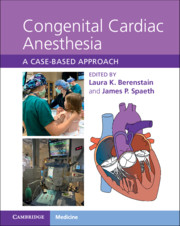Book contents
- Congenital Cardiac Anesthesia
- Congenital Cardiac Anesthesia
- Copyright page
- Dedication
- Contents
- Contributors
- Introduction
- Chapter 1 A Congenital Heart Disease Primer
- Section 1 Left-to-Right Shunts
- Section 2 Right-Sided Obstructive Lesions
- Section 3 Left-Sided Obstructive Lesions
- Section 4 Complex Mixing Lesions
- Chapter 21 d-Transposition of the Great Arteries (Arterial Switch)
- Chapter 22 d-Transposition of the Great Arteries (Atrial Switch)
- Chapter 23 l-Transposition of the Great Arteries (“Corrected” Transposition)
- Chapter 24 Total Anomalous Pulmonary Venous Return and Heterotaxy Syndrome
- Chapter 25 Truncus Arteriosus
- Section 5 Single-Ventricle Physiology
- Section 6 Heart Failure, Mechanical Circulatory Support, and Transplantation
- Section 7 Miscellaneous Lesions and Syndromes
- Index
- References
Chapter 22 - d-Transposition of the Great Arteries (Atrial Switch)
from Section 4 - Complex Mixing Lesions
Published online by Cambridge University Press: 09 September 2021
- Congenital Cardiac Anesthesia
- Congenital Cardiac Anesthesia
- Copyright page
- Dedication
- Contents
- Contributors
- Introduction
- Chapter 1 A Congenital Heart Disease Primer
- Section 1 Left-to-Right Shunts
- Section 2 Right-Sided Obstructive Lesions
- Section 3 Left-Sided Obstructive Lesions
- Section 4 Complex Mixing Lesions
- Chapter 21 d-Transposition of the Great Arteries (Arterial Switch)
- Chapter 22 d-Transposition of the Great Arteries (Atrial Switch)
- Chapter 23 l-Transposition of the Great Arteries (“Corrected” Transposition)
- Chapter 24 Total Anomalous Pulmonary Venous Return and Heterotaxy Syndrome
- Chapter 25 Truncus Arteriosus
- Section 5 Single-Ventricle Physiology
- Section 6 Heart Failure, Mechanical Circulatory Support, and Transplantation
- Section 7 Miscellaneous Lesions and Syndromes
- Index
- References
Summary
In “simple” dextro-transposition of the great arteries the great vessels originate from the wrong ventricle. Blood flows in a parallel fashion with deoxygenated blood recirculating to the body and oxygenated blood recirculating to the lungs. The resultant physiology is not compatible with life unless there is mixing between circulations. In the late 1960s, ingenious ways of rerouting atrial blood to the opposite ventricle were developed, and atrial switch procedures became the procedure of choice for the next 15–20 years until the arterial switch operation became standard treatment for this lesion. The atrial switch is no longer performed, but as of 2008, there were an estimated 9000 adult congenital heart disease patients in the United States who had undergone atrial switch procedures performed for the correction of dextro-transposition of the great arteries. This chapter discusses the assessment and management of an adult patient who underwent the atrial switch procedure and the perioperative concerns involved in care of these patients.
Keywords
- Type
- Chapter
- Information
- Congenital Cardiac AnesthesiaA Case-based Approach, pp. 145 - 157Publisher: Cambridge University PressPrint publication year: 2021

